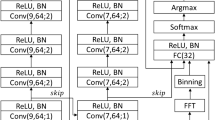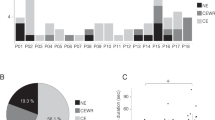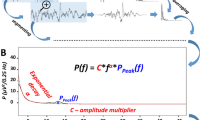Abstract
NORMAL sleep in man consists of two alternating phases which may be distinguished by electroencephalographic (EEG), electromyographic, electro-occulographic, autonomic and psychologic criteria1–3. The initial period of nocturnal sleep is characterized by EEG spindles and slow waves, partial preservation of muscle tone, and regularity of pulse and respiratory rates. After about 90 min, this non-rapid eye movement (NREM) phase of sleep gives way to a period of irregular, low voltage electrocortical activity, bursts of rapid eye movements, profound hypotonia of certain muscles, rapid alterations in cardiorespiratory function and in human dreaming. Ordinarily, rapid eye movement (REM) sleep alternates with NREM sleep four or five times each night, and occupies 20 per cent to 25 per cent of total sleep time.
This is a preview of subscription content, access via your institution
Access options
Subscribe to this journal
Receive 51 print issues and online access
$199.00 per year
only $3.90 per issue
Buy this article
- Purchase on SpringerLink
- Instant access to full article PDF
Prices may be subject to local taxes which are calculated during checkout
Similar content being viewed by others
References
Aserinsky, E., and Kleitman, N., Science, 116, 273 (1953).
Dement, W. C., and Kleitman, N., EEG Clin. Neurophysiol., 8, 673 (1957).
Snyder, F., Hobson, J. A., Morisson, D. F., and Goldfrank, F., J. Appl. Physiol., 19, 417 (1964).
Jouvet, M., Science, 163, 32 (1969).
Jouvet, M., and Delorme, J., CR Soc. Biol., 159, 895 (1963).
Jouvet, M., Bubillier, P., Pugol, J. F., and Renault, J., CR Soc. Biol., 160, 2343 (1966).
Delorme, F., Froment, J. L., and Jouvet, M., CR Soc. Biol., 160, 2347 (1966).
Oswald, I., Pharmacol. Rev., 20, 273 (1968).
Constantinidis, J., Bartholini, G., Tissot, R., and Pletscher, A., Experientia, 42, 130 (1968).
Rechtshaffen, A. F., in A Manual of Standardized Terminology, Techniques and Scoring System for Sleep Stages of Human Subjects (edit. by Land, A., and Kales, A.) (US Department of Health, Education and Welfare, PHS, NIH and NINDS, Bethesda, Maryland, 1968).
Butcher, L. L., and Engle, J., Brain Res., 15, 233 (1969).
Chase, T. N., Schnur, J., and Gordon, E. K., Intern. J. Neuropharmacol. (in the press).
Gebrode, F., and Bowers, M., J. Neurochem., 15, 1053 (1968).
Wyatt, R. J., Engleman, K., Kupfer, D. J., Scott, J., Sjoerdsma, A., and Snyder, F., EEG Clin. Neurophysiol., 27, 526 (1969).
Mandell, M. P., Mandell, A. J., and Jacobson, A. M., Rec. Adv. Biol. Psychiat., 1, 115 (1964).
Wyatt, R. J., Engleman, K., and Snyder, F., Psychophysiology (in the press).
Author information
Authors and Affiliations
Rights and permissions
About this article
Cite this article
WYATT, R., CHASE, T., SCOTT, J. et al. Effect of L-Dopa on the Sleep of Man. Nature 228, 999–1001 (1970). https://doi.org/10.1038/228999a0
Received:
Issue date:
DOI: https://doi.org/10.1038/228999a0
This article is cited by
-
Sleep disturbances in Parkinson’s disease
Current Neurology and Neuroscience Reports (2003)
-
Analysis of the structure of sleep and waking in rats with a parkinsonian syndrome induced by 1-methyl-4-phenyl-1,2,3,6,-tetrahydropyridine and by oxotremorine
Bulletin of Experimental Biology and Medicine (1989)
-
Suppression of REM and delta sleep by apomorphine in man: A dopamine mimetic effect
Psychopharmacology (1980)
-
Hypersomnia with simultaneous waking and sleep patterns in the electroencephalogram
Journal of Neurology (1979)



